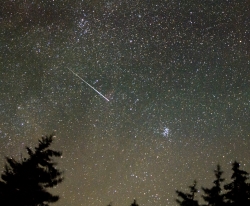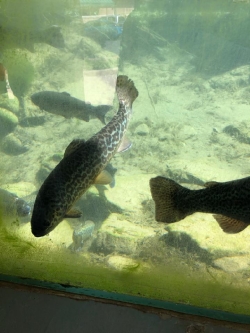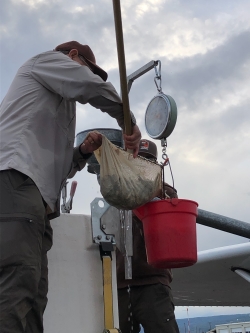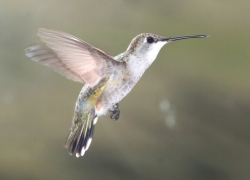
Archilochus alexandri
Courtesy US FWS, Alan Schmierer, Photographer
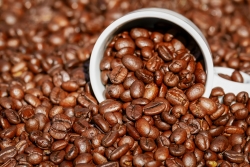 Roasted Coffee Beans
Roasted Coffee Beans
Courtesy Pixabay, Couleur, PhotographerSince 1956 the Bridgerland Audubon Society has been documenting about one hundred bird species braving our northern Utah winters, but there’s an equally wonderful array of birds that spend their summers in Cache Valley. Come fall, some of our most colorful summer denizens migrate south to spend the winter months on bird-friendly shade-grown coffee plantations in Latin America. These birds include the colorful yellow and orange Western Tanagers, Black-headed Grosbeaks, and Bullock’s Orioles as well as the intensely blue Lazuli Buntings and our tiny Black-chinned Hummingbirds with their iridescent purple necklace that shines like a neon light. In total, 42 migratory songbird species have been documented as flying from North America to shade-grown coffee plantations south of the border, and Bird-Friendly coffee is saving their habitat.
Our local Caffe Ibis website captures the importance of shade-grown coffee for migratory birds in featuring Bird Friendly coffee that “comes from family farms in Latin America that provide good, forest-like habitat for birds. Rather than being grown on farms that have been cleared of vegetation, Bird Friendly coffees are planted under a canopy of trees. These trees provide the shelter, food and homes that migratory and local birds need to survive and thrive.”
Shade-grown coffee is a mutually beneficial farming system for both migratory birds and coffee producers because the birds eat coffee insect pests and they help pollinate the flowers of the all-important shade trees. As a result, a single bird can provide the coffee producer with a much greater coffee harvest that amounts to up to 24 more pounds of coffee beans per acre each year. That increased yield means about 1,500 more cups of coffee provided by a single bird!
Certified Bird Friendly® coffee is a designation made by the Smithsonian Migratory Bird Center (SMBC). The gold standard for ethical, sustainable, organic coffee, this Bird Friendly certification helps ensure that growers can maintain shade-grown coffee practices rather than giving in to the economic pressure to produce habitat-destroying cheaper sun-grown coffee. Certification places value on the farmer and the habitat rather than on cheaper coffee. Because both sun-grown and shade-grown coffee farms span a large portion of important wintering bird habitat, you can help provide economic support for farmers protecting important bird habitat by buying sustainable “Bird Friendly” labeled coffees.
Shade-grown coffee farms are good for birds, good for people, and good for the planet. So, for those who enjoy coffee, bird-friendly coffee is all the more enjoyable because your selection is a positive conservation action. As you sip your Bird-Friendly certified coffee, just marvel at the fact that a hummingbird egg is about the size of a single coffee bean!
This segment concludes with a shout out to Caffe Ibis Coffee Maven Emerita Sally Sears, and another shout out to Lesa Wilson, who now carries the torch for Caffe Ibis, a community leader in sustainability that provides environmentally sound and ethically sourced coffee.
I’m Hilary Shughart, President of the Bridgerland Audubon Society, and I am Wild About Utah!
Credits:
Photo: Coffee beans, Courtesy Pixabay, Couleur, Photographer https://pixabay.com/photos/coffee-beans-seed-caffeine-cafe-3392159/
Photo: Black-chinned Hummingbird, Courtesy US FWS, Alan Schmierer, Photographer, https://images.fws.gov/
Featured Audio: Courtesy & Copyright © Kevin Colver, https://wildstore.wildsanctuary.com/collections/special-collections/kevin-colver
Text: Hilary Shughart, President, https://bridgerlandaudubon.org/
Additional Reading: Hilary Shughart and Lyle Bingham, https://bridgerlandaudubon.org/
Additional Reading
WildAboutUtah pieces by Hilary Shughart
Birds Supported by Coffee Farms, Smithsonian’s National Zoo & Conservation Biology Institute, https://nationalzoo.si.edu/migratory-birds/meet-birds-supported-bird-friendly-coffee-farms [link updated December 9, 2023]
Caffe Ibis Triple-Certified Bird-Friendly Coffees https://www.caffeibis.com/learn/bird-friendly-certified/
Caffe Ibis Coffee Roasting Company
52 Federal Avenue, Logan UT 8432
https://www.caffeibis.com
https://www.caffeibis.com/product-category/all-coffee/?filter_certifications=bird-friendly,fair-trade,organic
Trevino, Julissa, Coffee Growing Can Be Good For Birds, Smithsonian Magazine, Feb 20, 2018, https://www.smithsonianmag.com/smart-news/coffee-farms-are-good-birds-other-wildlife-study-finds-180968205/
Smithsonian Migratory Bird Center’s Bird Friendly® Coffee Program Protects Migratory Birds and Supports Shade-Grown Coffee Farms, Smithsonian Global, Smithsonian Institution, Jul 15, 2018, https://global.si.edu/success-stories/smithsonian-migratory-bird-center’s-bird-friendly®-coffee-program-protects-migratory
How Are Coffee And Birds Related?, All About Birds, The Cornell Lab of Ornithology, Cornell University, April 1, 2009, https://www.allaboutbirds.org/news/how-are-coffee-and-birds-related/
Black-chinned Hummingbird, All About Birds, The Cornell Lab of Ornithology, Cornell University, https://www.allaboutbirds.org/guide/Black-chinned_Hummingbird
Broad-tailed Hummingbird, Selasphorus platycercus, Field Guide, National Audubon, https://www.audubon.org/field-guide/bird/broad-tailed-hummingbird
Caffe Ibis Bird-Friendly Coffee List, https://www.caffeibis.com/learn/bird-friendly-certified/
french roast
quetzal
mexican chiapas
double french
fly catcher
espresso 44
dark peru
peruvian rainforest
condor coffee
guatemalan forest
anca/nature’s delight
decaf peru
la paz
dark guatamela
decaf mexican chiapas
new day
mocha
raspberry mocha
fresh vanilla
vanilla nut
bear lake raspberry
heavenly hazelnut

